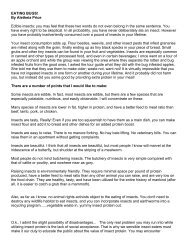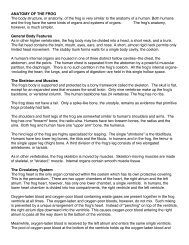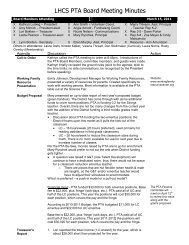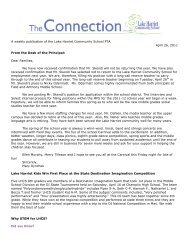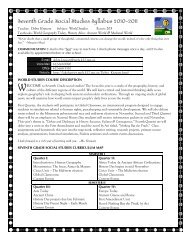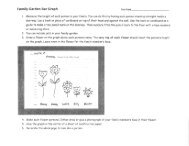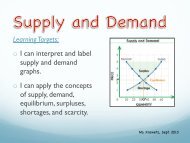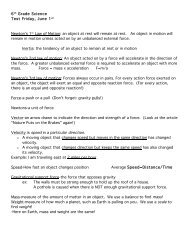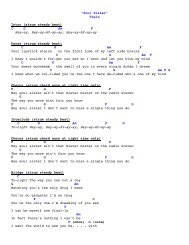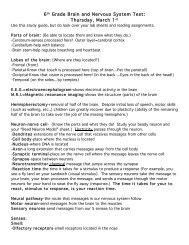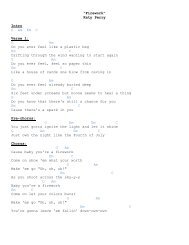FUR TRADE PROJECT-40 POINTS *Due Tues. Nov. 27, 2012
FUR TRADE PROJECT-40 POINTS *Due Tues. Nov. 27, 2012
FUR TRADE PROJECT-40 POINTS *Due Tues. Nov. 27, 2012
You also want an ePaper? Increase the reach of your titles
YUMPU automatically turns print PDFs into web optimized ePapers that Google loves.
Name Period Ms. Krawetz & Mrs. Busch – 6th Gr. S.S.<br />
<strong>FUR</strong> <strong>TRADE</strong> <strong>PROJECT</strong>-<strong>40</strong> <strong>POINTS</strong> <strong>*Due</strong> <strong>Tues</strong>. <strong>Nov</strong>. <strong>27</strong>, <strong>2012</strong><br />
You have a month to complete this project; NO late work will be accepted unless you are sick!<br />
I. <strong>PROJECT</strong> GOAL<br />
Complete a Fur Trade project from the list below and compile a bibliography listing the resources you<br />
used. You will visit the pubic library soon to borrow books for your project for your research. In class<br />
we’ll go over how to compile an annotated bibliography for listing photographs, books and websites.<br />
You will receive a few days in class to work on this, but plan on spending a SIGNIFICANT amount of<br />
time at home to complete this project.<br />
RESOUCES<br />
• Northern Lights textbook<br />
• Library books<br />
• MNHS or PBS Videos<br />
• Website resources.<br />
• Art Supplies: Paper, pencil, markers, fabric, felt,<br />
glue, scissors, etc.<br />
• Minnesota Historical Society<br />
• Refer to the bibliography of a Wikipedia article<br />
II.<br />
<strong>PROJECT</strong> OPTIONS<br />
A. SCRAPBOOK: THE LIFE OF GEORGE BONGA OR GEORGE NELSON<br />
Make a scrapbook chronicling the life of either George Bonga, an African American fur trade worker, OR<br />
George Nelson, a fur trade clerk. Decorate a cover, find (5) mementos reflecting important events in<br />
either George’s life, and compose a 4-5-sentence explanation for EACH memento describing its history and<br />
significance. Download a pdf biography on George Bonga or George Nelson on 6 th Gr HW downloads page.<br />
George Nelson Resources<br />
1. www.mnhs.org/school/historyplayers/core/nelson.htm<br />
2. www.mnhs.org/school/historyplayers/bios/george_bio.htm<br />
3. Book: My first years in the fur trade: The journals of 1802-1804, By George Nelson<br />
George Bonga Resources<br />
1. See Ms. Krawetz for PDF of George Bonga *Look on 6 th Grade HW downloads.<br />
2. www.aaregistry.org/historic_events/view/george-bonga-early-settler-minnesota<br />
3. Video: mnvideovault.org/search_results.php?q=bonga&search-go.x=0&search-go.y=0#<br />
4. MNHS Photo: http://collections.mnhs.org/visualresources/details.cfm?imageid=172662<br />
B. NORTH WEST OR HUDSON BAY <strong>FUR</strong> <strong>TRADE</strong> BROCHURE<br />
Make a tri-fold brochure about the North West or Hudson Bay Fur Trade Company. Explain the history of<br />
the company, the items traded, trading routes and maps, trading post locations, types of canoes, countries<br />
involved and about the positions the workers held. Write in bullet or list format instead of writing<br />
paragraphs. Insert pictures, maps and visuals on each page; this is a brochure NOT a report so have fun and<br />
make this creative. FYI: MSW has a brochure format.<br />
Web Resources on the Northwest Company:<br />
1. North West Company Fur Post: www.mnhs.org/places/sites/nwcfp/index.htm<br />
2. MHS Fur Trade Collection: www.mnhs.org/collections/museum/furtrade/furtrade.htm<br />
3. MHS North West Company Fur Post Background:<br />
http://events.mnhs.org/media/Kits/Sites/nwcfp/addBackground.htm<br />
4. Hudson Bay Company: http://www.canadiana.ca/hbc/intro_e.html<br />
5. Powell County Museum--Hudson Bay Company: http://www.pcmaf.org/hudson.htm
C. <strong>FUR</strong> <strong>TRADE</strong> NEWSPAPER<br />
Write a fur trade newspaper! Title your newspaper and write four articles set in the fur trade period.<br />
Article ideas to include: A story on a summer “rendezvous” at Grand Portage, figures such as George<br />
Bonga or George Nelson, European fur hats styles, types of canoes, an interview with a voyageur, job ads,<br />
pictures of items traded, etc. - Use the Web Resources listed in this packet!<br />
D. <strong>FUR</strong> <strong>TRADE</strong> PAPER BAG DRAMATICS<br />
Make or find FIVE of the items below, and then create a 3 character a, 3-4 page play to go with your bag of<br />
artifacts from the Fur Trade era. Items to select from: Beads, traps, earrings, gunflints, knives, beaver hat,<br />
kettles, pipes, sashes, wild rice, pelts, etc.<br />
MHS Fur Trade Collection: http://collections.mnhs.org/cms/results.php?keywords=fur+trade<br />
Use Chapter 5 of Northern Lights too!<br />
E. CREATE A SHOEBOX DIORAMA AND WRITE A PLAY<br />
Create a Fur Trade era shoebox diorama of a trading post or voyageurs traveling by canoe. In the diorama,<br />
show an “interaction” between the fur traders and the Native Americans and compose a 3 character, 3-4<br />
page play showing the people in your diorama interacting and discussing something that could have really<br />
occurred during the fur trade.<br />
F. ABC BOOKLET OR POWERPOINT<br />
Create an ABC booklet or PowerPoint on the Fur Trade period. Your booklet or PPT should include a<br />
cover, a word and sentence for each letter, and a picture for each letter.<br />
Ex: B: Beaver, “In the 18-century, hats made of beaver fur were the fashion rage in Europe.”<br />
G. THE OJIBWE’S PERSPECTIVE --- IN PICTURE BOOK FORMAT!<br />
Tell the story of the Fur Trade from the “perspective” of the Ojibwe people, like in the book, Night Flying<br />
Woman. Tell your story in the “voice” of a Native American, using phrases such as “animal brothers” and<br />
“si-si-gwad.” Your book should have a creative cover, and be 6-8 pages long; each page should contain both<br />
text and an illustration. It may be helpful to take Night Flying Woman home.<br />
III.<br />
GENERAL <strong>FUR</strong> TEADE RESOURCES & WEBSITES<br />
1. MNHS Fur Trade Collection Database: www.mnhs.org/collections/museum/furtrade/furtrade.htm<br />
2. MNHS Visual Images of the Fur Trade:<br />
http://collections.mnhs.org/visualresources/Results.cfm?Page=1&Keywords=fur%20trade&SearchType=B<br />
asic&CFID=7915942&CFTOKEN=66482603<br />
3. MNHS -- Minnesota Fur Trade: http://www.historicfortsnelling.org/history/fur-trade<br />
4. Canadiana.org: www.canadiana.org/hbc/intro_e.html<br />
5. White Oak Society: http://www.whiteoak.org/historical-library/fur-trade/fur-trade/<br />
6. Fur Trade at Fort Snelling: http://www.historicfortsnelling.org/history/fur-trade<br />
7. Northern Lights, Chapter 5: The Fur Trade<br />
8. Wisconsin Historical Society: Fur Trade History:<br />
http://www.wisconsinhistory.org/topics/shorthistory/furtrade.asp<br />
9. Economic History of the Fur Trade: http://eh.net/encyclopedia/article/carlos.lewis.furtrade
IV. COMPILING AN ANNOTATED BIBLIOGRAPHY<br />
*Try an online bibliography maker: www.easybib.com<br />
• A bibliography lists the sources used when writing a report. These include encyclopedias,<br />
textbooks, magazine or newspaper articles, reference books, interviews and Internet sites.<br />
• The purpose of a bibliography is to enable the people who are reading your report to check the<br />
facts, and to see if your conclusions are correct.<br />
• Each source in a bibliography includes a citation that includes the author’s name, title, and publication<br />
details of the source.<br />
• Each source in an annotated bibliography includes an additional annotation (a 1-2 sentence description)<br />
that comes after each citation. Sentence #1: What is the book/source about? #2: How did this<br />
source/book help you with your research?<br />
• The bibliography usually comes at the end of your report or essay. Here are some examples<br />
BOOK: SINGLE AUTHOR<br />
Citation (List in this order): The Author’s Last Name, First Name and Middle Initial. Title of Book. City:<br />
Publishing Company. Year Published.<br />
Annotation: Write 1-2 sentences summarizing the book, explaining how it helped you on your project.<br />
EXAMPLE<br />
Broker, Ignatia. Night Flying Woman. St. Paul, MN: Borealis Books, 1983.<br />
This book recounts the life of the author’s ancestor, “Night Flying Woman” who<br />
was born in the 1800’s during a time of great change for the Ojibwe people. This<br />
book helped me understand the impact of the Fur Trade on the Ojibwe people.<br />
!Citation<br />
Citation<br />
!Annotation<br />
BOOK: MULTIPLE AUTHORS<br />
List in this order: The authors’ last names alphabetically, the first author’s name is listed the same as a<br />
single author. The order of the second name starts with their first name and then last name. **Make<br />
sure to type “and” between the two names. The rest is the same as for one author.<br />
EXAMPLE<br />
Braun, Judy and Nancy Gilmore. Amazing Women in U.S. History. Chicago, IL: Bear Press, 1999.<br />
This book tells the overlooked stories of interesting women in U.S. history. I found a chapter on Alice<br />
Paul in this book that provided me with information for my project.
GENERAL ONLINE SITE<br />
List in this order: Title of Web Page. Year First Published. Institution. Date Accessed From the Internet<br />
. *The date the site was first published is at the bottom of the home page.<br />
EXAMPLE<br />
North West Fur Trade Company. 2000. Minnesota Historical Society. 24 <strong>Nov</strong>. 2008<br />
.<br />
The MHS site provided information on the North West Fur Company. The page helped me better<br />
understand why beavers were so much in demand and about the history of the hats.<br />
ENCYCLOPEDIA ARTICLE<br />
List in this order: The Author’s Last Name, First Name and Middle Initial. “Title of Article.” Tiitle of<br />
Ecyclopedia. Year Published.<br />
EXAMPLE<br />
Jones, Sylvia. "The Great Inca Civilization." Encyclopedia Britannica. 1990.<br />
This encyclopedia entry provided information on the Inca Civilization. This article was important to my<br />
project because it described in detail about the Inca sacred site, Macchu Pitchu.<br />
ENCYCLOPEDIA ARTICLE ONLINE<br />
List in this order: Title of Page, Name of Online Encyclopedia (*underlined). Date Accessed From the<br />
Internet .<br />
EXAMPLE<br />
"Stock Market Crash of 1929." Britannica Online. 24 <strong>Nov</strong>. 2008 .<br />
This article provided information about the various causes of the 1929 Stock Market Crash. I used facts<br />
and pictures from this article in my report.<br />
NEWSPAPERS ONLINE<br />
List in this order: The Author’s Last Name And First Name. “Title of Article.” Tiitle of Newspaper<br />
(*underlined). Date First Pubblished. Date Accessed From the Internet .<br />
EXAMPLE<br />
Kole William." Alps Glaciers Will Melt by 2050." The New York Times. 22 Jan. 2007. 21 Feb. 2007<br />
.<br />
This article explains how ice on the Swiss Alps is melting, and may disappear from the Alps within 30-50<br />
years. This article gave direct evidence for my thesis that global warming is actually caused by human<br />
mistreating the environment.
Name Period *Turn this rubric in with your project on <strong>Nov</strong>. <strong>27</strong>th<br />
V. <strong>FUR</strong> <strong>TRADE</strong> <strong>PROJECT</strong> RUBRIC -45 Points *You & a parent will fill out the rubric together!<br />
<strong>PROJECT</strong> TITLE:<br />
Paren<br />
t<br />
Student Teacher<br />
KEY 8=Excellent 7=Very Good 6 =Average 5= Needs Work 4=Missing/Incomplete: Redo<br />
1. RESEARCH: A significant amount of time was devoted to background reading &<br />
researching your topic. Your work reflects rich and in-depth content information.<br />
2. CREATIVITY: This project demonstrates creativity and originality that is “true” to<br />
the history of the Fur Trade era.<br />
3. WRITING: The written parts of your project demonstrate proper grammar, spelling,<br />
punctuation and neatness. Your writing is detailed and you elaborate on your ideas.<br />
4. ANNPTATED BIBLIOGRAPHY: The annotated bibliography follows the format<br />
introduced in class. You have at least (2) books in your bibliography. -See<br />
easybib.com<br />
5. TIME USAGE & ORANIZATION: Evaluate your use of time at home and at school.<br />
*Parents evaluate time spent on this at home.<br />
8 … 7 … 6 … 5 … 4<br />
6. RUBRIC COMPLETED: Return filled out & signed by <strong>Nov</strong>. <strong>27</strong>! *5 points 5 points Y or N: __<br />
Total Points:<br />
Comments: Address in what went well and what could have gone even better, research, creativity and<br />
organization. Ask a parent and a peer to evaluate your project and write a comment.<br />
A. Parent Comments:<br />
Parent’s signature:<br />
B. Student Comments:<br />
Student’s signature:<br />
C. Teacher Comments:<br />
Teacher’s signature:
MINNESOTA <strong>FUR</strong> <strong>TRADE</strong> BACKGROUND – MNHS<br />
AMERICAN INDIAN NATIONS traded along the<br />
Mississippi River for centuries before the arrival of<br />
Europeans in the mid-1600s. For nearly 200 years<br />
afterward, European traders exchanged<br />
manufactured goods with American Indian nations<br />
for valuable furs. Following the American<br />
Revolution, the U.S. competed fiercely with Great<br />
Britain for dominance of the North American fur<br />
trade. After the War of 1812 there were three<br />
main parties involved in the Northwest<br />
Territory's fur trade: American Indians (primarily<br />
the Dakota and Ojibwe), the fur trading companies,<br />
and the U.S. government. These parties worked<br />
together and each had something to gain from a<br />
stable trading environment. Both Fort Snelling and<br />
the Indian Agency were established at the river<br />
junction to help maintain stability of the region's fur<br />
trade.<br />
The DAKOTA AND OJIBWE were the primary<br />
trappers of fur-bearing animals in the Northwest<br />
Territory. They harvested a wide variety of furs<br />
(beaver the most valuable) in the region's woodlands<br />
and waterways. In exchange for these furs,<br />
French, British and U.S. traders provided goods<br />
such as blankets, firearms and ammunition, cloth,<br />
metal tools and brass kettles. The Dakota and<br />
Ojibwe had existed for thousands of years using<br />
tools made from readily available materials, but by<br />
the 1800s trade goods had become a part of daily<br />
life for many American Indian communities. Still,<br />
these trade goods often represented a trade-off:<br />
for example, metal trade knives may be more<br />
durable than traditional flint knives, but they were<br />
not as sharp. The main advantage of these trade<br />
goods lay in their availability. By the 1820s,<br />
however, some Dakota and Ojibwe communities<br />
had become dependent on trade goods for a<br />
certain level of prosperity and efficiency in their<br />
everyday lives. The fur trade had a tremendous<br />
effect on their cultures and influenced U.S.-<br />
American Indian economic and political relations<br />
and events in the 19th c.<br />
VOYAGEURS ("travelers" in French) were men hired<br />
to work for the fur traders to transport trade<br />
goods throughout the vast territory to rendezvous<br />
posts. At the rendezvous points these goods were<br />
exchanged for furs, which were then sent to larger<br />
cities for shipment to the east coast. Many traders<br />
and voyageurs married into American Indian<br />
communities, taking advantage of kinship networks,<br />
often trading exclusively within their particular<br />
community. As a result, large communities of<br />
individuals of diverse heritage developed, often called<br />
"mixed-bloods" or Métis during the period, and<br />
many of these individuals maintained ties to both fur<br />
trade and American Indian communities.<br />
SLAVERY also played a part in the fur trade, as some<br />
traders (including Henry H. Sibley and Jean-Baptiste<br />
Faribault) utilized slave labor. In some cases<br />
these enslaved people were freed by their masters,<br />
but often they remained part of the trade business.<br />
George Bonga was the son of a former slave and an<br />
Ojibwe woman and was active in the fur trade<br />
during the first half of the 1800s. Bonga was<br />
educated in Montreal and was well-known for his<br />
physical stature and strength. Often sought out for<br />
his skills as an interpreter, Bonga could speak<br />
French, English and Ojibwe. The Bonga family is<br />
just one example of the diversity and<br />
cultural exchange that resulted from the fur trade<br />
in the Northwest Territory.<br />
DECLINE: By the 18<strong>40</strong>s the fur trade had declined<br />
dramatically in the Minnesota region, partially due<br />
to changes in fashion tastes, the availability of lessexpensive<br />
materials for hat-making, and because<br />
Dakota and Ojibwe hunters had their available<br />
hunting grounds reduced through treaties with the<br />
U.S. government. Many fur traders took the<br />
opportunity to become land speculators, and<br />
economics in the region changed forever. For many<br />
Dakota and Ojibwe people, who had by this time<br />
become increasingly dependent on the trade,<br />
exchanging land in order to pay off debts claimed<br />
by traders became a matter of survival.



